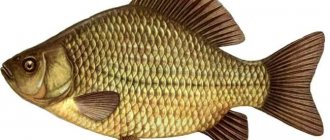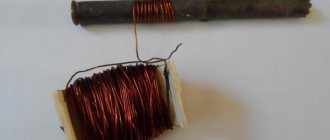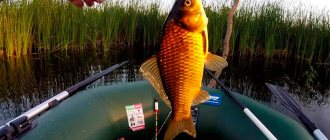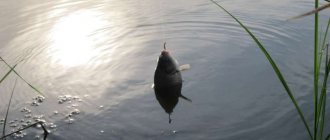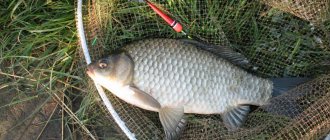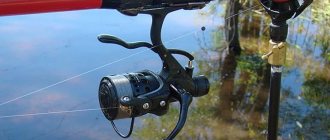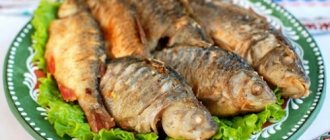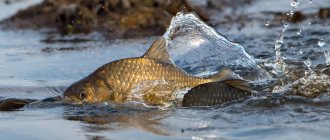Due to its wide distribution and accessibility, crucian carp is an excellent object for amateur fishing. He is quite omnivorous, his habits do not contain oddities and big whims, and fishing will not bring extreme surprises. For all these reasons, crucian carp is especially interesting for novice anglers. However, despite its simplicity, fishing for it requires certain skills, customized gear, knowledge of habits, preferences in bait and groundbait. Let's try to cover all these questions.
Choosing a fishing rod
The main factors influencing the choice of fishing rod when fishing for crucian carp are the location and fishing conditions.
Flywheel
This is the simplest tackle, which is a fishing rod with a fishing line attached to the tip, with a hook, sinker and float. Nowadays, telescopic blanks made of glass or carbon fiber act as fishing rods. They are light and convenient, and the use of connectors allows you to quickly and easily replace the entire equipment on such a fishing rod directly while fishing. The length of such rods ranges from 3 to 9 meters, but blanks from 4 to 6 meters are usually used.
Fly fishing rod
The advantages of a modern fly fishing rod are:
- lightness, which allows you to actively work with such a fishing rod for a long time, including for a child;
- simplicity, the absence of rings and a reel make it possible to manipulate such a fishing rod in difficult conditions of reeds, coastal bushes or an overgrown reservoir. A short fly rod is perfect for fishing from a boat;
- speed of equipment replacement, when you can quickly unhook one line from the connector and attach another.
The disadvantages of a fly rod are the inability to fish further from the shore and the difficulty of fishing at depth. In both cases, the distance is limited by the length of the rod itself.
For these reasons, a fly rod is chosen for catching crucian carp on small rivers and ponds, heavily overgrown reservoirs, and in reed thickets. When fishing from a boat in shallow waters.
Bologna
All the disadvantages of a fly rod are leveled out when using Bolognese tackle. These days this is the most common fishing rod, which is a fishing rod equipped with rings and a spinning reel. It allows you to fish directly using the fly method, as well as make long casts, fish at any depth, or float the bait downstream by unwinding the line from the reel. The usual length of a Bolognese fishing rod is the same as that of a fly fishing rod - from 4 to 6 meters.

Bolognese fishing rod
Its disadvantages include slightly greater weight, the possibility of the fishing line and rings getting tangled in the surrounding vegetation, and the difficulty of replacing equipment. To do this, you need to cut the line and re-equip it.
Bolognese tackle can be used wherever float fishing is possible. However, long-distance casting poses some problems.
Match
The problem of fishing with a float at large distances from the shore is solved by using a match rod. This is a lightweight plug form, usually two, less often three-legged. The average length of such a fishing rod is from 3 to 4 meters. It is equipped with guide rings on high stands, a spinning reel and a comfortable handle. At the tip of the blank there are several additional movably fixed rings, which help to evenly distribute the load when fishing.
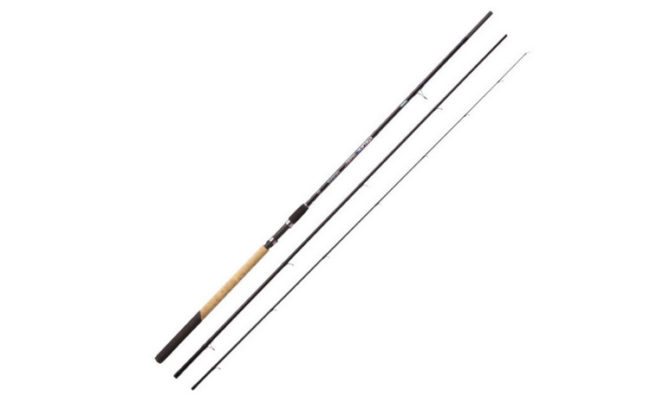
Match fishing rod
A special feature of the match rod equipment is the use of special weighted, sliding floats with good aerodynamics, allowing you to cast over long distances. The distance of such a cast is usually 40–60 meters.
Match fishing rods are used in the absence of a boat, on reservoirs with a heavily overgrown bottom, for catching large crucian carp far from the shore.
Pikernaya
Picker is the most lightweight version of the feeder. It is a lightweight (ultralight) feeder blank up to 3 meters long, equipped with a spinning reel, a light feeder or a sinker. The picker rod allows you to conduct bottom fishing at distances of up to 30 meters. Usually they catch crucian carp in small ponds and lakes or river creeks with a clean bottom. The most productive equipment with this method of fishing is the “death” of crucian carp. This is a specially equipped feeder that allows you to hook this fish yourself.
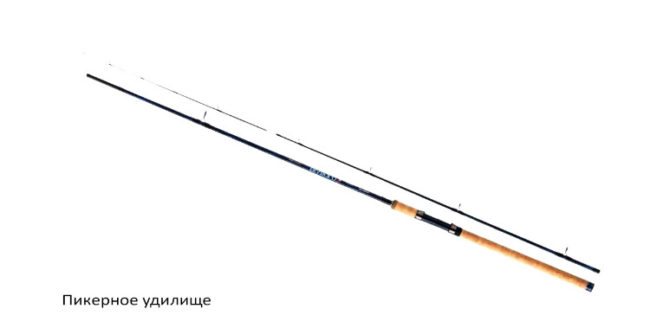
How to recognize a crucian bite
Crucian carp bites in its own way. After catching him several times, you will easily begin to distinguish his habits. According to generalized data, the entire process of biting it can be divided into three stages:
Stage #1:
Grade. Crucian carp is a “sniffing” fish. He has a naturally keen sense of smell. Therefore, you can attract him not only with standard, but also with specific smells. For example - kerosene.
So, the fish sees the bait, comes up and starts “sniffing”. Therefore, at this time it is advisable not to actively loom on the shore and not make noise. By the way, there is a belief that trophy fish, which have extensive experience in “escaping” from the hook, will circle around the bait they like for a very long time and evaluate its smell.
Stage #2:
The crucian carp liked the bait, it's time to try it. If the bait is large, the crucian carp will pinch it off in small portions until there is a piece left on the hook of a size that would easily fit into the fish’s mouth. During this time, the float will shake and rise and fall slightly. We muster our will and wait. You can hook, but it may not bring results. The fact is that all the bait has not even been in the fish’s mouth yet.
Stage #3:
The main thing here is not to oversleep. The crucian carp swallows the rest of the bait, at this time the float makes several rises, after which it can lie on its side or go to the side. It's time to hook!
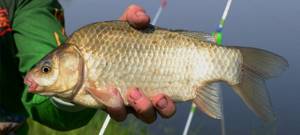
How to equip a fishing rod for crucian carp with a float
The equipment of a float rod for crucian carp does not differ in any specifics, but it has its own characteristics.
Hook selection
When choosing a hook, first of all, of course, you should focus on the size of the intended fish, but if you focus on the size that is familiar to many, a little larger than the average palm, then you should use hooks No. 16–10 according to the international classification.
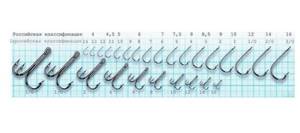
Classification of fishing hooks
The intended bait also makes adjustments to the hook size. So, for bloodworms they take a small thin hook, for a worm a little more, but in any case it will be a small hook with a straight shank from the middle price range.
Coil selection
The reel is chosen taking into account exactly how you are going to catch crucian carp. If it is just fly fishing with a float, then the simplest inertia-free or any inertial reel will be enough. When using long casts, you already need to use a better quality spinning reel. In general, float fishing for crucian carp does not place great demands on the reel.
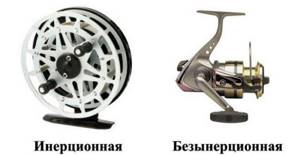
Float selection
The correct float is probably the most important element in a crucian carp rig. The fact is that crucian carp, despite its small size, also has a rather sluggish bite. Therefore, the float must be as sensitive as possible, which is achieved first by selecting the correct shape.
The optimal ones in this regard are:
- goose feather floats;

- pencil-shaped floats;

- small spindle-shaped floats with thin stems and tips.

Important! The top of the float should not be thick, otherwise when biting the crucian carp will feel resistance and spit out the bait.
The operating weight of the float, when fishing in calm weather at shallow depths, usually does not exceed 5 grams. When there is wind or fishing at depth, use floats of 5–10 grams. The heaviest ones are used for long-cast fishing.
Line selection
The fishing line is also selected depending on the size of the possible trophy, so you should focus on the range of 0.1–0.2 mm. For fishing with a fly rod for small crucian carp, a 0.1 mm fishing line is suitable. The classic size is slightly larger than the palm of your hand and weighs 250–350 grams; it is best to fish with a fishing line of 0.12–0.15 mm. A 0.2 mm fishing line will not greatly affect the bite of small fish, but it will help if a large crucian carp or small carp bites.
When fishing at depth or for long-distance casting, it is possible to use a 0.3 mm fishing line with 0.12–0.2 mm leaders.
Sinker
To load the float, use ordinary lead pellets. It is best to attach several of them, the heaviest one higher, and the lightest one closer to the hook.

Depending on its distance to the float, the sensitivity of the gear will be determined. Here you need to find a middle ground, between this very sensitivity and the caution of the crucian carp. Usually the weight is placed at a distance of 10–25 cm from the hook, depending on the bite.
Now let’s look at additional nuances and elements of equipment for crucian carp.
Stop Beads/Knots
When fishing for crucian carp by long casting, use a rig with a sliding float. To fix the immersion depth of the tackle, use a special stop bead or stop knot. They are placed on the main line and, as a rule, are made to shift. The stop bead is a small ball that easily passes through the passage rings, made of rubber or silicone with a slot or hole. They can be found in fishing stores. It sits quite tightly on the fishing line, but you can still move it along it by adjusting the depth.
A sliding knot can replace such a bead. It is knitted from fishing line, cord, woolen thread, rubber or silicone thread. When tying, use the same knots as for sliding leashes. Such a knot should move tightly along the main line.
Video: stopper knot
Two hooks
Often, experienced fishermen use a rig with two hooks when fishing for crucian carp. It is used most often when there is no reliable bite, little things are not annoying and there is a possibility that a large fish will bite. This allows you to use two different baits at once to decide on the right one.
The optimal leashes would be 10–15 cm, with the following placement options:
- one below, and the second 20–25 cm higher, between two sinkers;
- the large sinker is at the very bottom, and the leads are higher at a distance of 15–20 cm from it and from each other.
Other options, as a rule, are not so practical and lead to tangling of the gear.
Video: leash with two hooks for catching crucian carp
Mormyshka
In some cases, experienced fishermen practice catching crucian carp using a float rod with a jig. They do this when, for example, you need to fish in a very overgrown reservoir and the bait should fall into a small window in the grass without any deviations. When fishing in the reeds, here the jig, unlike the hook, will not get caught in the stems. If you need to fish at depth, a jig will provide a good sinking speed for the bait. If you need to cast some light bait further away, a jig will also help with this.
Jigs are used weighing up to 5 grams so as not to lose the sensitivity of the float. The main difference between a summer jig and a winter jig is the longer hook. Since summer baits often require larger sizes. The selection of the type of jig is usually situational and depends on the experience of the fisherman and local characteristics.
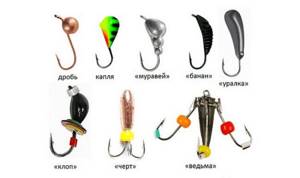
Jigs
Useful tips
- It is best to have several leash options with you on every fishing trip, which will differ in the length and thickness of the fishing line. To quickly replace them, you can use a system of fishing swivels and fasteners.
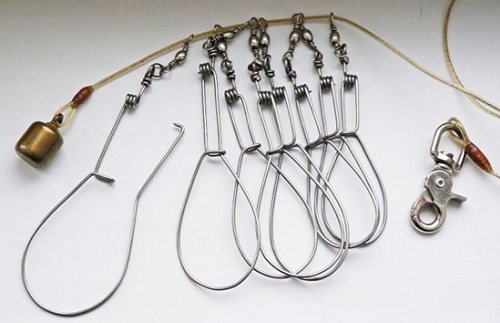
Having several leads in stock increases your chance of a good catch.
- When purchasing fishing line for leashes, remember that 90% of manufacturers deliberately underestimate its actual thickness by about 0.01–0.03 mm. Thus, it is possible to make “super-strong” fishing lines, which, with a small cross-section, show an excellent breaking load. Therefore, feel free to add another 5-10% to the information on the thickness of the monofilament indicated on the package.
- Never skimp on the leader line. It must be of the highest quality and most reliable, which is only available for sale. Moreover, its consumption is much less than that of the main fishing line. Therefore, when buying a reel of material 100-150 m long for leash installation, it will last you more than one year.
- We must not forget about the high-quality attachment of leashes to the main fishing line. After all, up to 40% of the strength is lost on a bad knot. It turns out that a palm-sized crucian carp, while offering decent resistance, can easily break off a poorly mounted leash. This will obviously upset the fisherman and, most likely, will be disastrous for the fish itself, in whose mouth the hook and line will remain.
From the video you will learn how to knit leashes for fishing:
How to load a float
One of the subtleties of setting up float tackle for crucian carp is loading the float. Since the crucian carp bite is very easy, and the crucian carp itself is careful, when biting it should not feel the slightest resistance that arises when the float is immersed. This is achieved due to the fact that a correctly loaded float has only a thin tip sticking out of the water, and everything else is under water.
You can load the float both at home and directly while fishing. At home, you can use a cut-off 2-liter plastic bottle for this. Loading begins with two sinkers, one large and the other smaller, with a total mass equal to the operating weight of the float. During a test dive, the entire float should disappear except the tip. If this is not the case, then we either add another sinker or reduce the weight by taking a second smaller sinker. As a result, the sinkers are placed on the fishing line at a distance of about 10 cm from each other.

Loading the float
Types of float rods
Since the fishing rod for catching crucian carp is used of a float type, you can consider all types of equipment and stop only at the fly version. Preference depends on personal experience, terrain and reservoir characteristics. In addition to the flywheel, Bolognese and match types of tackle are also used for fishing with a float device.
The Bolognese type of tackle resembles a long cane, from the tip of which a fishing line comes out. Such a rod has a number of design features that increase the effectiveness of fishing with it, and at the same time the cost of the gear. Important improvements, in comparison with such a simple device as a float tackle for crucian carp, include:
- built-in spool holder;
- pass rings that prevent the line from sticking to the form during fishing;
- telescopic rod device.
The match fishing rod is available in two versions: telescopic and plug-in. The telescopic type is produced with fewer passage rings than the Bologna type, and in practice it turns out to be more fragile than the plug-in type.
A match-type float rod is good to use in water with minimal current, or better without it at all. Using different floats and variations in the complexity of the structure of the device, you can control the length of the nozzle, lowering it to different depths and experiment with fishing techniques.

Baits and baits
Crucian carp is far from a gourmet, and feeds on the principle: “Everything that fits into your mouth is healthy.” Therefore, the main criterion for choosing baits and lures is the relative familiarity of the given food to it. This is the case with most plant baits of local origin and familiar live baits - worms and larvae.
Plant attachment
Plant baits for crucian carp, according to the degree of attractiveness, include:
- semolina chatter;
- mastyrka from semolina and peas;
- steamed pearl barley;
- dough made from semolina or other flour with various flavors;
- special boilies for crucian carp;
- steamed peas;
- steamed or boiled wheat;
- corn;
- other plant baits characteristic of the area.

The preferences of crucian carp and the use of plant baits very much depend on the situation, so there are no uniform recommendations for their use. One day he will prefer his usual pearl barley, and on another he will need to use something completely new and unfamiliar from the category of boilies with an exotic smell. Therefore, with plant baits you should always be ready to experiment.
Animal attachment
Depending on the circumstances, crucian carp can eat most animal baits, but three are almost universal :
- maggot;
- earthworm (dung, earthworm, crawling, etc.);
- bloodworm.

These are the baits that he recognizes and, other things being equal, will always prefer them. But there are times when plant baits work better. You need to be prepared for this.
Bait for crucian carp
Like most other carp fish, crucian carp can and should be fed. The bait can be either purchased or homemade. The first is more universal, the second usually takes into account local characteristics and preferences.
Purchased
Purchased bait for crucian carp can be divided into several types:
- plasticine is bait with a consistency similar to it. Most often, plasticine is used for bottom fishing. Comes in a wide variety of scents. The classic smells for crucian carp are garlic, anise, hemp, peas, but often it reacts to completely different smells;
- ordinary groundbaits - to prepare them, simply moisten them and, perhaps, add filler from some kind of porridge for more quantity. They come in a wide variety of flavors and compositions. Usually mixtures for crucian carp are specially labeled or are indicated in the recommendations for use;
- groundbait in granules - made from fish meal, similar to those used for industrial fish feeding. They have a longer lasting effect. They are specially flavored and oils are added, which create a long-lasting aromatic cloud at the bait site.

Bait "plasticine"
Homemade
Homemade baits are made from various legumes and grain cereals with the addition of both natural and industrial flavors.
For porridges take:
- peas;
- millet;
- semolina;
- crushed barley or wheat;
- cracked corn;
- oatmeal, barley, etc.
For scent use:
- garlic;
- sunflower cake, oil or seeds;
- hemp seeds or oil;
- anise oil;
- Corvalol;
- other industrial flavors.
Video: simple do-it-yourself bait for crucian carp
Fishing with a float
A float rod allows you to fish in areas of reservoirs with a depth of up to 2–2.5 meters from the shore and 3–4 meters from a boat. At great depths, a float rod becomes inconvenient to use. Although crucian carp feeds from the bottom, as a rule, it prefers plant foods, so it is rarely found at great depths. He prefers to look for food in reeds, on the edges of the shore near thickets of grass, in shallow overgrown bays, ponds, rivulets, ditches and other similar bodies of water. For this reason, a float rod is the optimal tackle for catching it.
From the shore
When fishing from the shore, you need to focus on bays, driftwood lying near the shore, passages in reed thickets, and thickets of coastal vegetation. On rivers these are places with a slow flow, various bays and creeks overgrown with vegetation. For fishing, choose areas with a depth of 1–2 meters, and in shallow reservoirs 0.5–1.5 meters. The height of the float is set so that the hook is at the very bottom.
The fish bite is rarely very active, so when fishing from the shore, special rod stands are often used. At the beginning of fishing, the place is actively baited. The frequency of recasts will depend on the availability of small fish.
In the reeds
Reeds and other coastal vegetation are a favorite habitat and feeding place for crucian carp. They catch it at the border of reeds and open water, in passages and bays existing in the reeds. Moreover, the deeper in such a place, the greater the chance of catching a large specimen. Often, holes for fishing in the reeds are created artificially by independently clearing a small section of the shore from it.
When fishing in the reeds, it is better to use a fly rod, as it will get less tangled there.
Often on reservoirs with a bank heavily overgrown with reeds, it is quite difficult to get to its edge, and in this case it is best to use a boat.

From the boat
Using a boat when fishing for crucian carp is convenient not only because you can fish in any, even the most inaccessible place in the reeds. In reservoirs with shallow depths, it will allow you to catch it in almost the entire water area. In addition to the border of the reeds near the shore, when fishing from a boat, they choose places near islands of high underwater vegetation rising from the bottom, accumulations of snags, the border of depth changes, thickets of reeds in shallow waters in open water.
For fishing, fly or Bolognese rods up to 3 meters long are used, or small fishing rods with a sliding float. For fishing, they choose places with depths of 2–3 meters, especially in the summer heat, when crucian carp move to cooler waters.
Any boat will do, but it’s easier to keep quiet in an inflatable boat, while with a metal or wooden one it’s easier to move around a body of water.
Fishing technique
After the fisherman has decided on a place, he needs to make bait.
After about half an hour, you should make the first cast. Note: Each angler has his own preference for how to cast, but the most favorite method is over the right shoulder.
Next, you can hold the fishing rod in your hand or put it on a flyer that sticks into the bottom of the bank or reservoir.
When biting you need:
- Take a close look at the float (make sure that the vibrations are not caused by the current).
- Wait until the float moves to the side. Crucian carp almost always bite quite quietly.
- At the moment of complete slowdown of the float, make a hook.
Main requirements for hooking:
- It is imperative to do this at the moment when the float has stopped and lies horizontally on the water.
- Do it quite sharply. If you miss this moment, then the risk that the fish will spit out the bait is extremely high.
When fishing for crucian carp, there are rarely any difficulties; usually there is no special resistance on their part.
Basic rules for fishing:
- Do it exclusively while standing.
- As quickly as possible so as not to break, but at the same time not abruptly.
Seasonal features
Depending on the time of year, the habitats and preferences of crucian carp change somewhat.
Spring
In the spring, after ice drift, crucian carp migrate to shallow, sun-warmed areas of the reservoir, closer to the shore. Since there is still little vegetation in the water, it is focused on animal food - worms, maggots, bloodworms. As the water warms up, the crucian carp moves to shallow areas of the reservoir with the remains of last year's vegetation, and by May, when the shallow water is overgrown with fresh grass, cattails and reeds, it moves there. Throughout this season, as the underwater vegetation blooms, he gradually adds plant bait to his diet.
Summer
The main summer bite occurs in the morning and evening dawns. As the water heats up, the crucian carp gradually moves to depth and shaded areas. It is caught on both animal and plant baits. By August it can be found at different depths, and night fishing is also possible at this time.
Video: catching crucian carp on a float in summer
Autumn
Autumn forces the crucian carp, as the water cools and the vegetation dies, to descend deeper and deeper into the depths where they will spend the winter. The bite occurs in the middle of the day, on warm, sunny days. Regarding food, preferences are again shifting towards animal baits.
Winter
In winter, crucian carp stays at depths, closer to the fresh stream. The bite occurs towards the middle of the day on animal baits.
Since crucian carp is very widespread and ubiquitous, found in reservoirs of various types, from overgrown ditches to large river reservoirs, its habits and preferences vary greatly. Therefore, for successful fishing you need to either use the advice of local fishermen, or constantly experiment yourself.
Length of leashes for feeder fishing for crucian carp
The most difficult thing is to choose leashes for catching crucian carp on a feeder. We have already noted above that their length can vary from 20 to 80 cm. Moreover, some fishermen use longer leash structures (about 1 m) on the English donka. Therefore, the logical question becomes: “How do you understand what length of fishing line should be on the leashes on the feeder?”
Many will say that the larger it is, the better. But that's not true. The leashes on the feeder simply do not have the correct length. The fact is that it depends on many factors:
- places on a body of water;
- bottom features;
- season;
- water and air temperatures;
- weather conditions;
- current forces;
- sensitivity of gear and rod;
- habits and preferences of the fish itself.

When choosing the length of the feeder leads, a number of features should be taken into account
This list could go on for quite a long time. Therefore, experienced fishermen, coming to a reservoir, constantly experiment with the length of leashes. Otherwise, catching crucian carp on a feeder, especially large ones, can sometimes be difficult. However, by choosing the optimal length of fishing line from the feeder to the hooks with nozzle, you can count on a good catch.
Of course, usually leashes are placed on the feeder, the length of which is about 40 cm. Most often, this is enough to place the bait not close to the feeder, but so that it is in the field of view of the crucian carp attracted by the bait. But it also happens that fish only bite on feeder equipment with short (about 20 cm) or, conversely, long (about 80-100 cm) leashes. So anglers have to constantly try different options.
